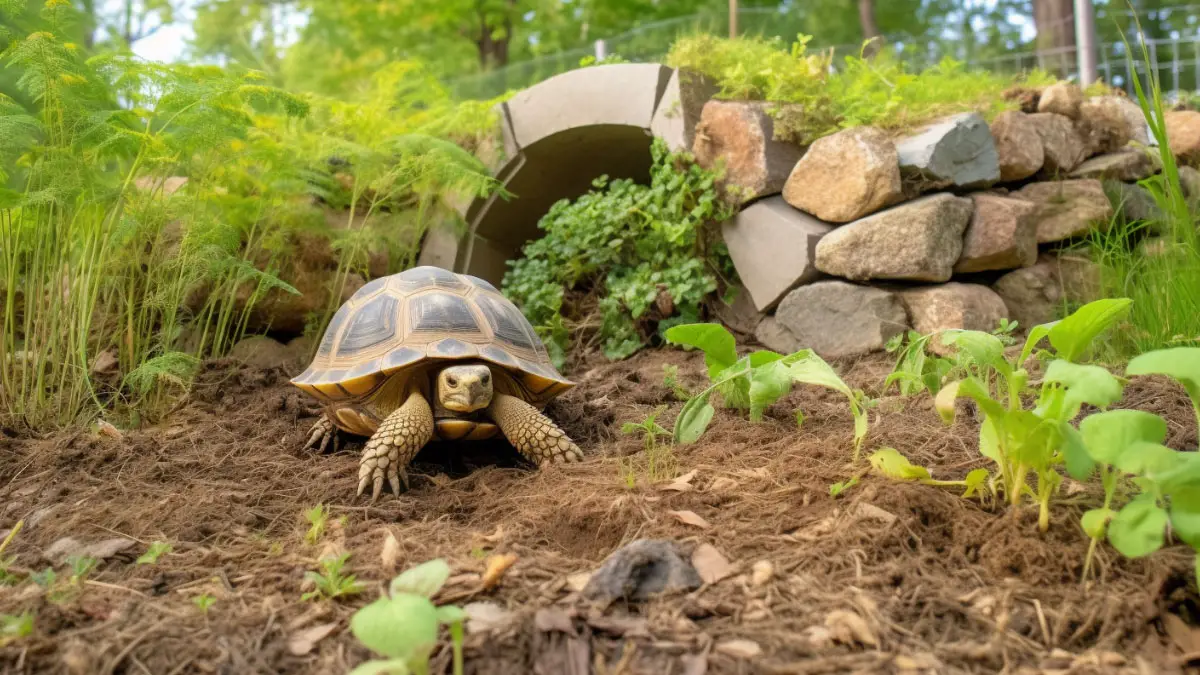How To Setup A Tortoise Enclosure? Ensure Your Pet’s Comfortability
All set to buy your very first pair of tortoises? Good for you! But before you bring those ancient reptiles home, you must have an enclosure for your pets.
But how to setup a tortoise enclosure? Typically, tortoise enclosures are made with plywood, plastic, or glass. Before you make one, you must select a suitable location outdoors or indoors. After that, you must line the bottom of the enclosure with fine grain, such as sand.
Set up a heat lamp to ensure the perfect temperature inside the enclosure and UVB lighting. That’s not all. Let’s get into the details and find out how you can set up a proper enclosure for your tortoise.
Things to Consider Before Setting Up A Tortoise Enclosure
Contents
Just like any other pet, tortoises also have special habitat requirements. You must keep these ancient animals comfortable as they can easily fall sick otherwise.
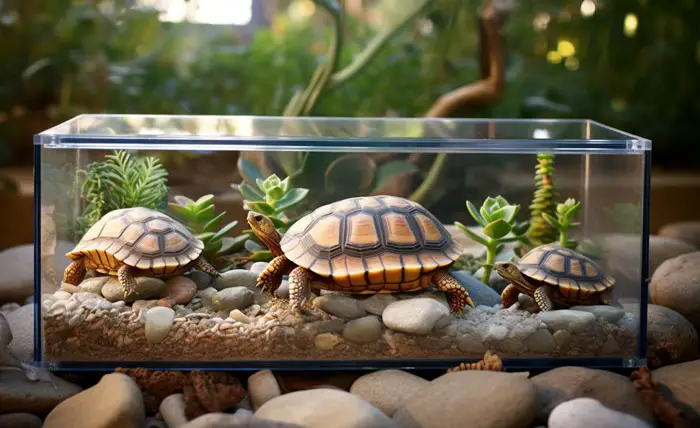
To tailor the enclosure to your tortoise’s specific needs, consider the following factors-
Tortoise Species
Different tortoise species require different habitats. Some prefer high temperatures, while some like airy and cold locations. So, you must research the specific needs of your tortoise species.
Learn about their specific requirements for temperature, humidity, and space before making them an enclosure.
Indoor vs. Outdoor
Determine whether you want to set up an indoor or outdoor enclosure. Tortoise owners usually prefer outdoor enclosures for larger species. Such enclosures allow you to provide more natural sunlight.
However, indoor enclosures have their benefits depending on your climate and available space.
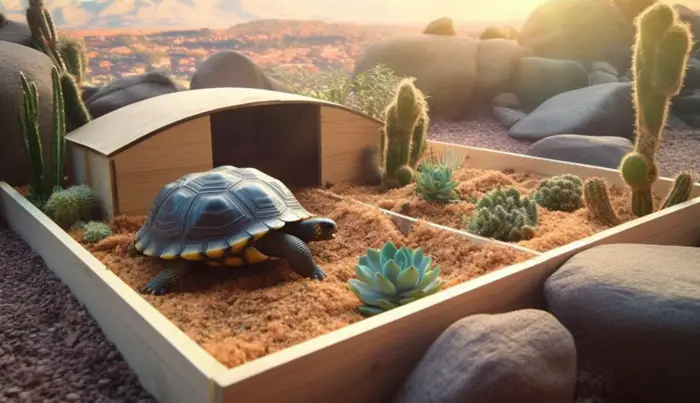
Enclosure Size
As your tortoise will live in the enclosure for decades, you have to ensure it’s large enough for your tortoise to move around comfortably. As a general rule, the enclosure should be at least five times the length and three times the width of your tortoise.
So, if your tortoise is 10cm in length, you’ll need a 50cm x 30cm enclosure.
Bottom Substrate
Once you’ve set up the boundary, you need to choose an appropriate substrate or flooring material. Pet owners commonly use coconut coir, cypress mulch, and a mixture of topsoil and play sand.
Avoid using materials like gravel or wood shavings, as they can cause impaction if ingested.
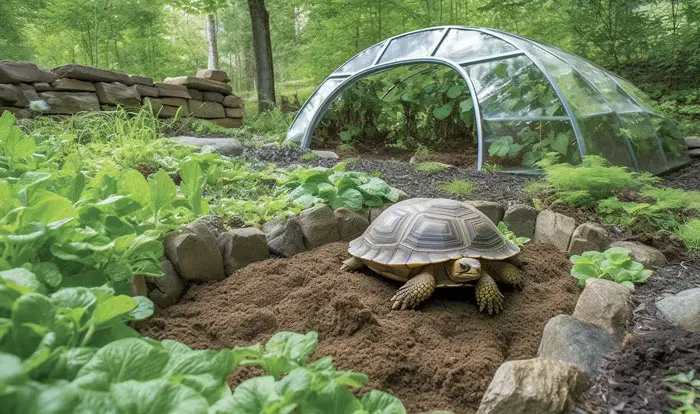
Temperature
You must provide a temperature gradient within the enclosure, with a basking area at one end and a cooler area at the other. The basking area should have a heat source to maintain the appropriate temperature for your tortoise species.
Heat lamps are the most popular option, but you can go for any available substrate.
UVB Lighting
To mimic the sunlight, you must arrange adequate UVB lighting. It’s essential for calcium absorption and maintaining the good health of your tortoise. Use a UVB bulb specifically designed for reptiles and place it as recommended by the manufacturer.
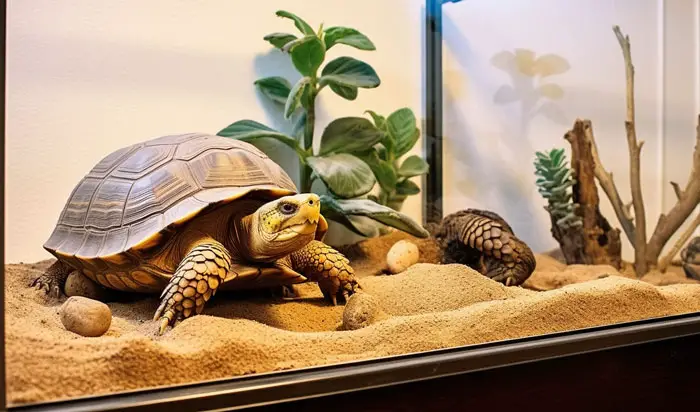
Humidity
Maintain the appropriate humidity level for your tortoise species. For this, you can mist the enclosure, use a humidifier, or provide a shallow water dish.
Security
Make the enclosure as secure as possible to prevent your tortoise from escaping and protect it from potential predators.
Set Up A Tortoise Enclosure: Step-By-Step
Now that you know about the must-have features of a tortoise enclosure, it’s time to get into the setup. To make an ideal enclosure for your tortoise, follow the step-by-step process given below.

Step 1: Choose the Right Construction Materials
From glass to plywood, you can choose any strong material for a tortoise enclosure. The glass-made vivarium is a popular choice nowadays as it allows the owner to monitor the tortoise’s behavior. Besides, the sliding front door makes cleaning easier.
For outdoor enclosures, you can go for plywood as the material is strong enough to protect the animal. If you’re keeping the tortoise indoors, tortoise tables with a lid on the top will be an ideal option.
Accordingly, the size of the enclosure should be at least 4-6 times the length of your tortoise. However, we recommend going for 10 times larger enclosures so that the tortoise gets sufficient space when it grows up.
Step 2: Add the Bottom Substrate
Your tort needs a softer floor to walk on and dig in. So, the enclosure needs a suitable substrate. The substrate is the material that lines the bottom of the enclosure. As mentioned, coconut coir, cypress mulch, or a mixture of topsoil and play sand are some preferred substrates.
However, if you don’t have these, go with regular soil or sand. Always keep the substrate humid as tortoises prefer about 70% humid substrate. Muddy clay, dry sand, pine shavings, paper, wood chips, etc., aren’t suitable substrates. Avoid these to protect your tort from injury and dryness.
Step 3: Set the Temperature
To regulate their body temperature, tortoises require a temperature gradient in their habitat. Hence, you have to create a basking area with a temperature of 90°-100°F (32°-38°C). Besides, the cooler end of the enclosure should maintain a temperature of 70°-80°F (21°-27°C).
Remember, some tortoises prefer even hotter environments. So, do your research to find out the right temperature for your tortoise species.
Place a heat lamp at one end of the enclosure to keep your tortoise warm. Use a thermometer to monitor the temperatures and adjust the heat lamp as needed.
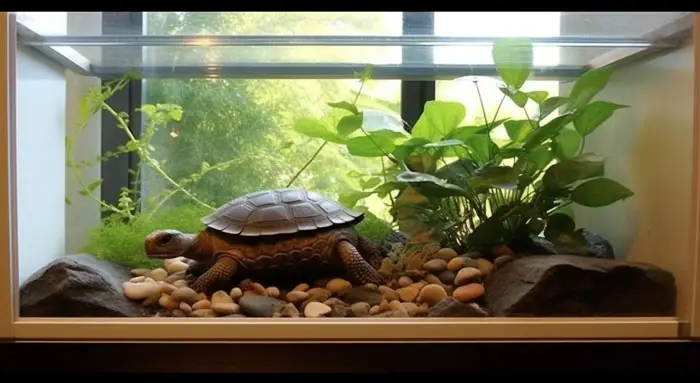
Step 4: Provide UVB Lighting
Whether the enclosure is placed indoors or outdoors, you’ll always need a UVB light. Tortoises need to be exposed to sunlight to maintain their health. Even if the enclosure is outside, you’ll need a UVB light during the winter and rainy days.
The UVB light is essential for your tortoise to synthesize vitamin D3. It allows calcium absorption and healthy shell growth. Install a UVB light in the enclosure, ensuring it covers at least two-thirds of the area. You might have to replace the bulb every 6-12 months as the UVB output decreases over time.
Step 5: Arrange Hiding Spots
Don’t expect your tortoise to stay in one corner of the enclosure. It will roam around, dig, flip, dive in, and play as it wishes. Moreover, tortoises appreciate having hiding spots to retreat to when they feel threatened or stressed.
So, you need to provide at least one hide per tortoise, such as a half-log or a cave made from rocks. You can also include climbing opportunities like flat rocks or logs to encourage exercise and other natural behaviors.
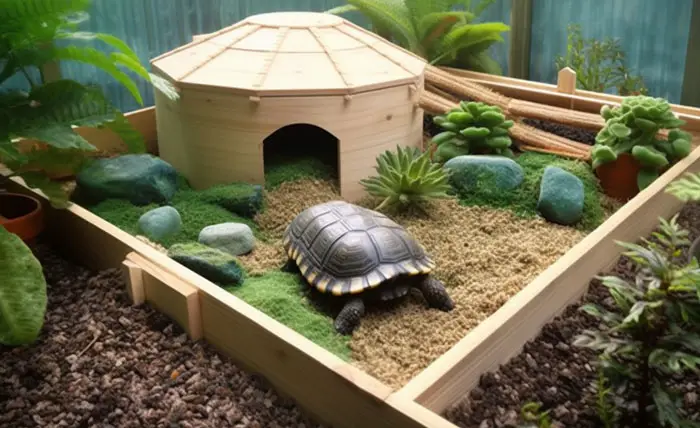
Step 6: Place A Dish and Humidifier
To offer your tortoise food, place a feeding dish in one corner of the enclosure. You have to arrange a shallow dish of fresh water too for your tortoise to drink from and soak in.
If you live in a dry and cold climate, you might have to place a humidifier inside the enclosure to adjust the moisture levels.
Wrapping Up!
So, now you know how to setup a tortoise enclosure. All you have to do is choose a strong and protective material for the enclosure, place sand in the bottom, control the temperature, and place a UVB light.
It’s a general process that works for most tortoise species. However, you must research your specific tortoise species’ requirements and consult with a reptile veterinarian for additional guidance.

